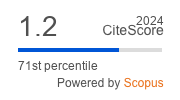The language of the weather forecast in Italian and Spanish television broadcasts: Linguistic-descriptive analysis of the end of winter on RTVE and TG5 television channels
DOI:
https://doi.org/10.29038/eejpl.2023.10.1.valKeywords:
atmospheric language, atmospheric forecasting, probability, technicalities, scientific contextAbstract
Weather information is of great importance to society due to the impact of the physical environment on everyday life. As a result, popular tradition has disseminated many proverbs related to human activities that have been the subject, over time, of scientific studies, intending to verify the veracity of such predictions. For this reason, this article initially presents a brief bibliographical and regulatory analysis of the evolution of atmospheric language and a presentation of the bodies that regulate its communication in Spain and Italy. Subsequently, a corpus of weather reports extracted during December 2022 from an Italian and Spanish news channel will be illustrated to study the communication of weather forecasts from a macro- and microstructural linguistic level, given the need for studies in both languages. For this purpose, Speechnotes will be used for the transcriptions, and Sketch Engine to create the corpus. As a result of the analysis, Spanish news programmes devote more time to the space of time, show a much higher speed of locution than the Italian corpus, provide a more significant number of mechanisms to show probability and uncertainty, and a great variety of linguistic-discursive strategies to exemplify the scientific context. We also find a recurrent gerund, which we will call an "atmospheric gerund". In Italian, on the other hand, we find greater deixis, more synthetic information, and less dynamism in the interaction with the data.
Funding Statement
This work has been funded by the Margarita Salas grants for the training of young doctors (2021-2023) of the University of Salamanca.
Author: Rubén González Vallejo,
 0000-0002-9697-6942
0000-0002-9697-6942  u156528@usal.es
u156528@usal.es
Downloads
References
Álvarez Pérez, X. A. (2013). Distribución geoparemiológica de refranes meteorológicos asturianos. Lletres Asturianes, 109, 67-102. https://www.divulgameteo.es/fotos/meteoroteca/Refranes-meteorol%C3%B3gicos-asturianos.pdf
Calzacorta Elorza, J. (1999). Estructura de los refranes meteorológicos castellanos, franceses y vascos. Paremia, 8, 95-102. https://www.divulgameteo.es/uploads/Estructura-refranes-meteorol%C3%B3gicos.pdf
Crespo, E., Revilla, J. C., & Elizaga, F. (2014). Meteorología y sociedad: uso y evaluación de la información meteorológica. Comunicación y Sociedad, 27(2), 169-194. http://dx.doi.org/10.15581/003.27.2.169-194
Dal Maso, E. (2019). Estudio funcional y lexicográfico de la polisemia simétrica y asimétrica en un corpus bilingüe de locuciones meteorológicas del español y del italiano. Lingue Linguaggi, 33, 41-53. http://dx.doi.org/10.1285/i22390359v33p41
García Gabaldón, J. (1994). Modos del tiempo (de la producción a la comprensión del discurso audiovisual informativo). In J. A. Fernández Roca, C. J. Gómez Blanco & J.M. Paz-Gago (Eds.), Semiótica y modernidad: actas del V Congreso Internacional de la Asociación Española de Semiótica (pp. 471-480). Universidad de La Coruña.
García-Legaz Martínez, J. (2007). ¿Quién predice el tiempo? Reivindicación del “pronóstico reservado”. Meteored, 1-3. https://www.divulgameteo.es/uploads/Pron%C3%B3stico-reservado.pdf
García Mouton, P. (2012). Refranes meteorológicos en el Atlas lingüístico (y etnográfico) de Castilla-La Mancha. Géolinguistique, 13, 127-138.
https://digital.csic.es/bitstream/10261/123075/3/Refranes_meteorol%c3%b3gicos_Atlas.pdf
Gill, J. (2008). Cómo pueden comunicar la incertidumbre en la predicción los proveedores de servicios. Boletín de la OMM, 237-347. https://www.tiempo.com/ram/4839/cmo-pueden-comunicar-la-incertidumbre-en-la-prediccin-los-proveedores-de-servicios/
Hall, A. (2017). ¿Un día perfecto para tender la colada, o probabilidad de lluvia del 10%?, Cómo hablar sobre riesgo e incertidumbre en las predicciones del tiempo por Alexander Hall, ganador del Premio Pictet. Boletín de la OMM, 66(1), 58-61. https://public.wmo.int/es/resources/bulletin/%C2%BFun-d%C3%ADa-perfecto-para-tender-la-colada-o-probabilidad-de-lluvia-del-10-c%C3%B3mo
Mancuso, A., Elia, A., Laudanna, A., & Vietri, S. (2020). The role of syntactic variability and literal interpretation plausibility in idiom comprehension. Journal of Psycholinguistic Research, 49, 99–124. https://doi.org/10.1007/s10936-019-09673-8
Nadav-Greenberg, L. & Joslyn, S. L. (2009). Uncertainty forecasts improve decision making among nonexperts. Journal of Cognitive Engineering and Decision Making, 3(3), 209–227.
https://doi.org/10.1518/155534309X474460
Peña Huélamo, F. J. (1999). La meteorología en las paremias hispano-italianas del mes de enero. Paremia, 8, 375-380. https://cvc.cervantes.es/lengua/paremia/pdf/008/059_pena.pdf
Palomares Calderón de la Barca, M. (2015). Breve historia de la Agencia Estatal de Meteorología. AEMET. https://www.aemet.es/documentos/es/conocenos/nuestra_historia/breve_historia_AEMET.pdf
Prior, A., Wintner, S., Macwhinney, B., & Lavie, A. (2011). Translation ambiguity in and out of context. Applied Psycholinguistics, 32(1), 93-111. https://doi.org/10.1017/S0142716410000305
Raimondi, A. (2010). Impacto social de la comunicación de las predicciones del tiempo. Actas de las Jornadas Científicas de la Asociación Meteorológica Española, 31. https://pub.ame-web.org/index.php/JRD/article/view/2098/2313
Raimondi, A. (2012). ¿El público entiende las predicciones del tiempo? Resultados de una investigación desarrollada en Italia y España. In XXXII Jornadas Científicas de la Asociación Meteorológica Española, 1-19. https://repositorio.aemet.es/bitstream/20.500.11765/5816/1/Raimondi.pdf
Rúa Aller, F. J., & García Armesto, M. J. (2010-2011). Refranero meteorológico en León. Tierras de León, 130, 193-230. https://www.divulgameteo.es/uploads/Refranero-meteorol%C3%B3gico-Le%C3%B3n.pdf
Sidoti, R. (2020). Los pronósticos del tiempo en las paremias del español y del italiano: frecuencia de uso y contextos en la información periodística en línea. Tonos Digital, 38. https://digitum.um.es/digitum/bitstream/10201/86336/1/2417-6667-1-PB.pdf
Sources
Organización Meteorológica Mundial. (2008). Directrices sobre la comunicación de la incertidumbre de las predicciones. https://library.wmo.int/doc_num.php?explnum_id=4686
Downloads
Published
Issue
Section
License
Copyright (c) 2023 Rubén González Vallejo

This work is licensed under a Creative Commons Attribution 4.0 International License.












 Creative Commons «Attribution» 4.0
Creative Commons «Attribution» 4.0